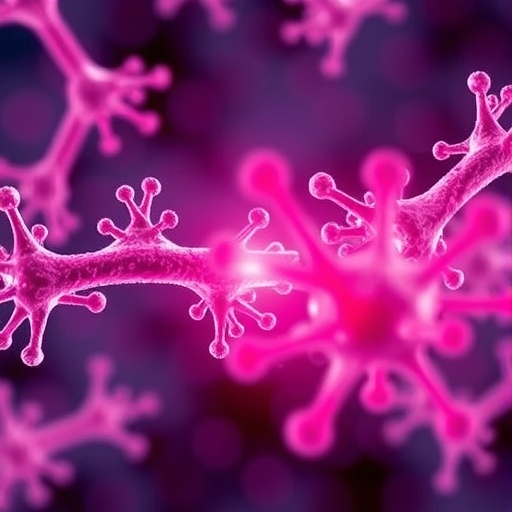
A groundbreaking study published in Nature unveils a novel chemogenetic strategy that harnesses cocaine’s molecular interactions to curb drug-seeking behaviors, marking a transformative advance in addiction neuroscience. By engineering synthetic ion channels activated selectively by cocaine, researchers have formed an innovative physiological intervention that blunts cocaine’s reinforcing effects through targeted modulation of neuronal circuits. This techno-biological approach holds immense promise for developing precision therapeutics aimed at addiction.
At the heart of this research lies a sophisticated molecular design combining elements of the α7 nicotinic acetylcholine receptor ligand-binding domain (LBD) with tailored ion pore domains (IPDs) from 5HT3 and Glycine receptors. The team generated chimeric channels—termed coca-5HT3 and coca-GlyR—built on human and murine protein sequences. Through meticulous site-directed mutagenesis, subtle amino acid substitutions enhanced cocaine’s agonism, converting a drug typically associated with neuromodulatory disruption into a ligand for synthetic receptor activation.
Expression systems were finely tuned, employing human embryonic kidney (HEK) 293 cells to verify the channels’ membrane behavior and responses. The constructs were expressed from pcDNA3.1 vectors, enabling high-efficiency transfection and subsequent functional characterization. To facilitate in vivo and circuit-specific applications, adeno-associated viral (AAV) vectors packaged with synapsin promoters and flex systems allowed for Cre-dependent regional gene delivery, establishing powerful tools for neuroscience investigations in animal models.
Cocaine’s precise mode of interaction with these engineered ion channels was illuminated through a structural modeling approach. Utilizing the crystal framework of cocaine bound to acetylcholine-binding proteins (PDB: 2PGZ), the researchers performed computational substitutions to map homologous human residues. This guided the rational engineering of mutant channels exhibiting heightened cocaine sensitivity, effectively transforming cocaine from a passive neurotransmitter transporter blocker into an ion channel agonist.
Functional assays employed the FLIPR membrane potential kit, quantifying channel activation across a range of cocaine concentrations in HEK293 cells. The engineered channels generated sigmoidal dose-response curves indicative of robust and graded activation. Critically, parallel whole-cell voltage-clamp electrophysiology validated these findings, demonstrating that mutant channels elicited measurable currents upon cocaine application. This dual confirmation underscores the precision and reliability of the synthetic receptors as cocaine-sensitive actuators.
The work extended beyond cell lines, integrating chemogenetic manipulations into neuronal cultures and acute brain slices, notably focusing on hippocampal pyramidal cells and lateral habenula (LHb) neurons. Using electroporation and viral targeting, the channels’ effects on neuronal excitability and intrinsic membrane properties were explored. Recordings revealed that cocaine application modulated firing thresholds and membrane resistance in transduced neurons, evidencing the synthetic receptors’ capacity to reshape cellular physiology in response to the drug.
Behavioral paradigms in rodents provided the most compelling insights. Rats transduced with coca-5HT3 vectors in the LHb exhibited marked reductions in cocaine self-administration, locomotor hyperactivity, and sucrose reinforcement, reflecting an attenuation of both drug-seeking and natural reward processes. These findings suggest that targeted chemogenetic activation can alter motivational states and reward circuit function in vivo, offering a translational avenue for addiction treatment.
Neurochemical assays complemented these behavioral outcomes. ELISA measurements of dopaminergic markers in striatal tissue revealed significant modulations in dopamine levels corresponding to chemogenetic manipulation. PET imaging with [^18F]fallypride supported these observations, demonstrating altered dopamine D2 receptor occupancy dynamics post-cocaine administration in treated animals. These imaging data affirm the mechanistic link between synthetic receptor activation and native dopaminergic signaling pathways.
Advanced fiber photometry techniques employing the genetically encoded dopamine sensor GRAB_DA1m enabled real-time tracking of dopamine release in response to cocaine. The study documented blunted dopamine transients in the nucleus accumbens medial shell of chemogenetically treated rats, leveraging optical readouts to directly correlate synthetic receptor function with neurotransmitter flux. This integration of optical physiology with chemogenetics exemplifies the multidisciplinary rigor defining this research.
Histological analyses confirmed the precise localization of viral vector expression and synthetic channel integration, utilizing immunohistochemistry with mCherry and GFP markers. These spatial verifications underpin the specificity and targeted nature of the intervention and ensure that behavioral and physiological effects can be confidently ascribed to the intended brain regions and cellular populations.
Importantly, the researchers employed rigorous statistical methodologies, including mixed-model ANOVA and correction for multiple comparisons, to validate their findings across multiple behavioral, electrophysiological, and biochemical assays. Transparent reporting and methodical design enhance the reproducibility and credibility of the results, setting a high standard for future chemogenetic studies.
The implications of this innovative chemogenetic design are profound. By turning cocaine—a notoriously addictive and deleterious substance—into a synthetic receptor agonist, this approach inverts traditional conceptions of drug targeting. It suggests a therapeutic paradigm wherein addiction-related molecules become precision tools for modulating malfunctioning circuits, potentially mitigating craving and relapse with minimal off-target effects.
This pioneering work lays a strong foundation for next-generation neurotherapeutics aimed at substance use disorders. Further refinement of receptor design and delivery vectors could broaden the applicability to other drugs and behavioral phenotypes. Such synthetic physiology promises a future where neurological interventions are customizable, reversible, and finely tuned to individual neurochemical landscapes.
As addiction continues to pose a significant global health challenge, the ingenuity embedded in this cocaine chemogenetics platform offers hope. By bridging molecular engineering, systems neuroscience, and behavioral science, it charts a path toward innovative, mechanism-based treatments that transcend conventional pharmacology.
Subject of Research: Synthetic receptor engineering and chemogenetic modulation to blunt cocaine-seeking behavior.
Article Title: Cocaine chemogenetics blunts drug-seeking by synthetic physiology.
Article References:
Gomez, J.L., Magnus, C.J., Bonaventura, J. et al. Cocaine chemogenetics blunts drug-seeking by synthetic physiology. Nature (2025). https://doi.org/10.1038/s41586-025-09427-8
Image Credits: AI Generated
Tags: adeno-associated viral vectors in gene deliverychemogenetic strategies for addiction treatmentchimeric channel design in neurosciencecocaine-driven drug-seeking behaviorsengineering synthetic ion channelshuman embryonic kidney 293 cells in addiction studiesneuronal circuit modulation in addictionneuroscience advancements in addiction therapyprecision therapeutics for addictionsite-directed mutagenesis in drug developmenttargeted modulation of cocaine effectsα7 nicotinic acetylcholine receptor research





